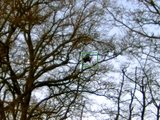BAE Systems to continue RAAF Wedgetail EW support
BAE Systems has signed a $77 million contract extension with Boeing Defence Australia (BDA) to continue to support electronic warfare sub-systems on the Royal Australian Air Force’s (RAAF’s) Wedgetail Airborne Early Warning and Control aircraft.
BDA signed a contract earlier this month to continue its support of the RAAF Wedgetail fleet through to 2019.
The contract will see BAE Systems continue its work to provide engineering, maintenance and spares support for the Wedgetail electronic warfare suite. This equipment is operated by on-board sensor specialists to locate and identify radar emitters and to protect the aircraft and its crew from potential missile threats.
Kim Scott, director land and integrated systems, said: ‘We are very pleased to retain this work and specialist skills in South Australia. We trust that continued success on this programme will help demonstrate that this type of advanced technology and capability can be provided locally to world standards.’
Mark Horton, acting Wedgetail in-service support program manager, BDA, added: ‘BAE Systems is a key partner in the Wedgetail support programme. The extension to BAE Systems’ contract recognises the results achieved during the initial support period and continues the excellent partnership we have established.’
The new contract will see BAE Systems continue its work on the programme through to 2019. Following that there is a provision for ongoing extensions, subject to satisfactory performance.
More from Digital Battlespace
-
![EID to unveil new vehicle communication system at DSEI]()
EID to unveil new vehicle communication system at DSEI
The Portuguese company’s naval communications system is in service across more than a dozen countries. It has turned to its home nation for support in developing a new vehicle based C2 system.
-
![Chess Dynamics successfully demonstrates Vision4ce AI-driven tracker]()
Chess Dynamics successfully demonstrates Vision4ce AI-driven tracker
The Vision4ce Deep Embedded Feature Tracking (DEFT) technology software is designed to process video and images by blending traditional computer vision with artificial intelligence (AI) algorithms to present actionable information from complex environments.
-
![Wave Relay devices cleared for security use on commercial systems in industry trend]()
Wave Relay devices cleared for security use on commercial systems in industry trend
Persistent Systems has been cleared by National Security Agency (NSA) to transmit sensitive data on commercial networks. The devices are added to the NSA’s Commercial Solutions for Classified (CSfC) component list which also includes other companies’ products providing the same security.
-
![UK teases cyber spending boost in Strategic Defence Review ahead of “imminent” release]()
UK teases cyber spending boost in Strategic Defence Review ahead of “imminent” release
The release of the UK’s Strategic Defence Review (SDR) has been long promised as mid-year. It is possible it could be as early as 2 June although the UK Ministry of Defence (MoD) continues to play its cards close to its chest.
-
![Intelsat emphasises SATCOM resilience for SOF in contested domains (video)]()
Intelsat emphasises SATCOM resilience for SOF in contested domains (video)
Intelsat outlines how its multi-orbit SATCOM architecture is enhancing connectivity and resilience for special operations forces operating in degraded and contested environments.
-
![US Space Force’s next-generation missile warning system moves forward with $500 million in new contracts]()
US Space Force’s next-generation missile warning system moves forward with $500 million in new contracts
Next-Generation Overhead Persistent Infrared (Next-Gen OPIR) satellites are intended to provide early warning of missile launches from any location worldwide and new ground stations will result in expanded coverage of critical missile warning.























